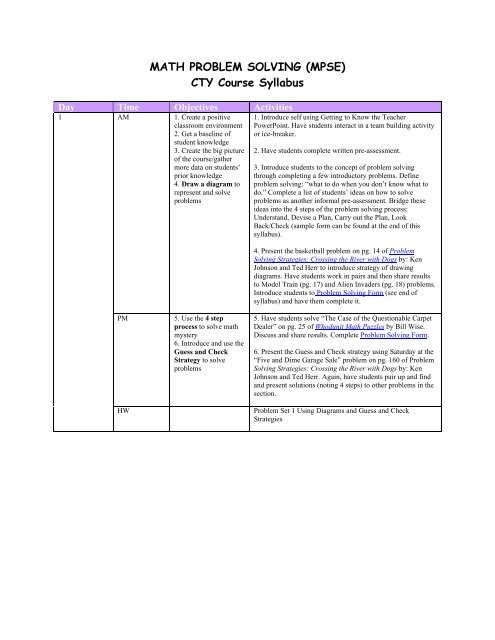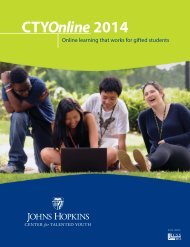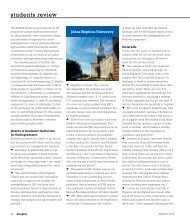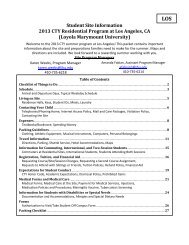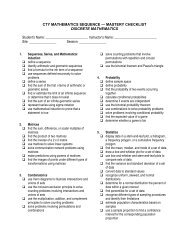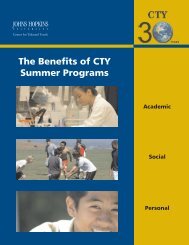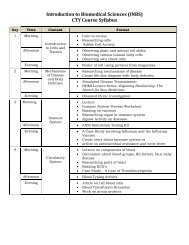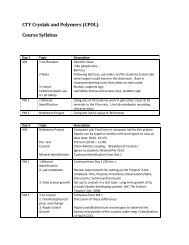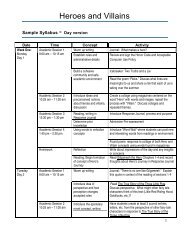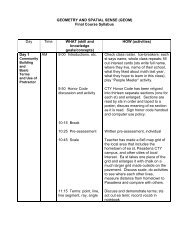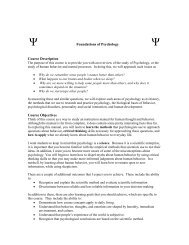MATH PROBLEM SOLVING (MPSE)
MATH PROBLEM SOLVING (MPSE)
MATH PROBLEM SOLVING (MPSE)
Create successful ePaper yourself
Turn your PDF publications into a flip-book with our unique Google optimized e-Paper software.
<strong>MATH</strong> <strong>PROBLEM</strong> <strong>SOLVING</strong> (<strong>MPSE</strong>)<br />
CTY Course Syllabus<br />
Day Time Objectives Activities<br />
1 AM 1. Create a positive<br />
classroom environment<br />
2. Get a baseline of<br />
student knowledge<br />
3. Create the big picture<br />
of the course/gather<br />
more data on students’<br />
prior knowledge<br />
4. Draw a diagram to<br />
represent and solve<br />
problems<br />
1. Introduce self using Getting to Know the Teacher<br />
PowerPoint. Have students interact in a team building activity<br />
or ice-breaker.<br />
2. Have students complete written pre-assessment.<br />
3. Introduce students to the concept of problem solving<br />
through completing a few introductory problems. Define<br />
problem solving: “what to do when you don’t know what to<br />
do.” Complete a list of students’ ideas on how to solve<br />
problems as another informal pre-assessment. Bridge these<br />
ideas into the 4 steps of the problem solving process:<br />
Understand, Devise a Plan, Carry out the Plan, Look<br />
Back/Check (sample form can be found at the end of this<br />
syllabus).<br />
4. Present the basketball problem on pg. 14 of Problem<br />
Solving Strategies: Crossing the River with Dogs by: Ken<br />
Johnson and Ted Herr to introduce strategy of drawing<br />
diagrams. Have students work in pairs and then share results<br />
to Model Train (pg. 17) and Alien Invaders (pg. 18) problems.<br />
Introduce students to Problem Solving Form (see end of<br />
syllabus) and have them complete it.<br />
PM<br />
HW<br />
5. Use the 4 step<br />
process to solve math<br />
mystery<br />
6. Introduce and use the<br />
Guess and Check<br />
Strategy to solve<br />
problems<br />
5. Have students solve “The Case of the Questionable Carpet<br />
Dealer” on pg. 25 of Whodunit Math Puzzles by Bill Wise.<br />
Discuss and share results. Complete Problem Solving Form.<br />
6. Present the Guess and Check strategy using Saturday at the<br />
“Five and Dime Garage Sale” problem on pg. 160 of Problem<br />
Solving Strategies: Crossing the River with Dogs by: Ken<br />
Johnson and Ted Herr. Again, have students pair up and find<br />
and present solutions (noting 4 steps) to other problems in the<br />
section.<br />
Problem Set 1 Using Diagrams and Guess and Check<br />
Strategies
Day Time Objectives Activities<br />
2 AM 1. Utilize the strategy<br />
of making an<br />
organized list to solve<br />
problems<br />
2. Develop and use<br />
basic concepts of<br />
probability to solve<br />
problems<br />
1. Pose this problem: In the cafeteria at (fill in name of site<br />
here) they are offering three different main dishes and four<br />
types of beverages. How many different “meals” (drink and<br />
main dish) could you get? Discuss some of the possibilities.<br />
Then, ask “How can we be sure we are getting all the<br />
possibilities?” Brainstorm ways we can make an organized<br />
list.<br />
Introduce the students to Bobby Lee. Bobby Lee wants more<br />
variety in his wardrobe. He has 3 shirts, 2 pairs of pants, and 2<br />
pairs of shoes. How many outfits does he have? Next, have<br />
students cut out shirts, pants, and shoes to determine the<br />
number of outfits that can made. They may glue the possible<br />
outfits on a larger sheet of poster board.<br />
(See<br />
http://illuminations.nctm.org/LessonDetail.aspx?ID=L180 for<br />
example)<br />
Re-visit making an organized list after students have<br />
physically made the outfits. For an extra challenge, add in<br />
another clothing item…how many does he have now? Have<br />
students practice strategy of making a list when given The<br />
Modern Basketball Association (pg. 32) and Loose Change<br />
(pg. 29) problems from Problem Solving Strategies: Crossing<br />
the River with Dogs by: Ken Johnson and Ted Herr.<br />
2. Show students a standard six-sided die. Ask students that if<br />
I were to roll it, how likely would it be that I get a 2? How do<br />
they know? How can we describe this? Introduce basic<br />
concept of probability (favored event/possibilities). Have<br />
students play race game with dice. (Have each student pick a<br />
number – can be on a car or horse —see who wins). Play<br />
game at least ten times. Then, combine the class data. Did it<br />
matter what numbers were picked? Were some better than<br />
others? Present several other scenarios using colored cubes,<br />
coins, and spinners. Have students complete problem sets<br />
associated with each item in pairs and then share results.<br />
PM<br />
HW<br />
3. Combine the use of<br />
lists and probability<br />
concepts to solve<br />
problems.<br />
3. Solve “The Case of the Carnival Probability Game” from<br />
Whodunit Math Puzzles by Bill Wise pg. 5. Complete Problem<br />
Solving Form. Discuss results.<br />
Revisit the cafeteria problem from earlier in the day. Ask<br />
students how likely it would be if all main dishes and<br />
beverages were randomly distributed for me to get Main Dish<br />
1 and Beverage 3. How can we figure this out? Brainstorm<br />
and Revisit list.<br />
Have students complete extensions of outfit problems using<br />
probability concepts. For an extra challenge, discuss the<br />
probability of randomly getting a double scoop cone with<br />
vanilla and chocolate if an ice cream shop has 31 flavors.<br />
Problem Set 2 (Finding probability, making lists)
Day Time Objectives Activities<br />
3 AM 1. Use the strategy of<br />
drawing a diagram<br />
(namely a tree<br />
diagram) to solve<br />
problems<br />
2. Use diagrams, lists,<br />
and concepts of<br />
probability to solve<br />
problems<br />
1. Have students conduct this simulation: You are going to the<br />
zoo. You only have time to visit one cage at each of 3<br />
locations (The Australian Outback, the African Savannah, and<br />
the Rainforest.) In the Outback, there are 4 cages to observe.<br />
In the Savannah there are 6 cages to observe, and in the<br />
Rainforest there are 2 cages to observe. How many possible<br />
combinations of cages can you visit? Discuss how we solve<br />
the problem (Make a list…) Walk through process of creating<br />
a tree diagram. Then ask follow-up questions (e.g., How<br />
likely is it that you would see monkeys, kangaroos, and<br />
alligators?)<br />
2. Give groups of students set of problems that could utilize<br />
tree diagrams (menus, songs on a CD, etc.)<br />
PM<br />
HW<br />
3. Investigate and use<br />
patterns as well as lists<br />
and diagrams to<br />
determine orderings<br />
(Permutations).<br />
3. Ask students how many different ways we could line up or<br />
how many different ways they could rearrange the letters in<br />
their names. Discuss strategies we can use to figure the<br />
problem out. Try them. Look at making lists and diagrams.<br />
Next, read Anno’s Mysterious Multiplying Jar by Mitusmasa<br />
Anno. Make diagrams to illustrate factorials and have students<br />
complete practice problems.<br />
Problem Set 3 Using Making a List and Diagram Strategies<br />
and Probability<br />
4 AM 1. Use patterns and<br />
models to recognize<br />
and manipulate<br />
fractional relationships.<br />
1. Introduce pattern blocks. Have students work through<br />
questions at http://math.rice.edu/~lanius/Patterns/. Stop after<br />
each section to discuss. Allow students ample time to create<br />
their own designs and then analyze the patterns and fractional<br />
relationships within.<br />
PM<br />
HW<br />
2. Use patterns,<br />
diagrams, and<br />
models/simulations to<br />
solve a problem.<br />
To culminate, have students create a “Quilt of Fourths.” Each<br />
student can create several squares split into fourths in different<br />
ways. See examples at<br />
http://www.lucinda.net/surber/graphics0203/fourth_quilts2.jpg<br />
.<br />
2. Present students with “The Handshake Problem.” (See<br />
http://dwb4.unl.edu/calculators/activities/middle/shake.html )<br />
Have students try to solve it on their own for about 10-15<br />
minutes. Then, discuss what they have been trying.<br />
Brainstorm ways we can solve it if needed. Have students get<br />
into groups of 2 or 3 and complete their solution and put on<br />
large white paper or poster to share. Have each group share<br />
their solution.<br />
Solve “Missing Country Club Funds” on pg. 29 of Whodunit<br />
Math Puzzles by Bill Wise. Complete on Problem Solving<br />
Form.
Day Time Objectives Activities<br />
5 AM 1. Revisit the<br />
importance of<br />
communicating<br />
mathematical<br />
thoughts and<br />
processes through<br />
writing and explanation<br />
2. Use pattern<br />
recognition and guess<br />
and check to decipher a<br />
code.<br />
1. Give students several examples of “Good, bad, and ugly”<br />
responses and explanations of problems. Have students<br />
construct their own good, bad, and ugly responses to a given<br />
problem and share results.<br />
2. Explain the different between a code and cipher. Have<br />
students provide examples of each. Present students with<br />
ciphered sentence (Caesar’s cipher). Discuss strategies we<br />
may use to figure it out. Work through deciphering together.<br />
Have students develop their own Caesar cipher paragraph (to<br />
be traded later).<br />
PM<br />
HW<br />
3. Continue work with<br />
codes.<br />
3. Trade and decipher paragraphs. Share interesting<br />
observations.<br />
* If students finish early/aren’t challenged have Mastermind<br />
tournament and have students present their strategies when<br />
breaking the code. Available online at<br />
http://www.irt.org/games/js/mind/<br />
Problem Set 4 (Review of strategies/problems from the week)<br />
6 AM 1. Use pattern<br />
recognition and guess<br />
and check to decipher<br />
codes.<br />
2. Use pattern<br />
recognition to develop<br />
strategies in playing a<br />
game.<br />
1. Solve “Coded Calculator Clue” in Whodunit Math Puzzles<br />
by Bill Wise pg.79. Complete Problem Solving Form.<br />
2. Introduce The Factor Game with age problem. (Today<br />
Jamie is 12 years old. Jamie has three younger cousins: Cam,<br />
Emilio and Ester. They are 2, 3, and 8 years old<br />
respectively…) Play factor game and discuss strategies.<br />
Discuss the use of patterns in factors to solve problems such<br />
as the one posed at the beginning of class. See the website<br />
following for details: http://wwwtc.pbs.org/teachers/mathline/lessonplans/pdf/msmp/factor.pdf<br />
PM<br />
HW<br />
3. Understand how<br />
letters or symbols can<br />
represent numbers and<br />
extend this concept to<br />
develop own code.<br />
(Introduce Translation<br />
Project)<br />
3. Introduce students to the concept of representing numbers<br />
with variables. Complete lesson at<br />
http://illuminations.nctm.org/LessonDetail.aspx?ID=L291<br />
including extension. Introduce students to the “Lost in<br />
Translation Project” in which students will be deciphering a<br />
code and then either creating their own or exploring the one<br />
given in greater depth. Students will also need to explain how<br />
the mathematics of their code as well as create a story about<br />
the people or beings that use their code. (Example: ** could<br />
represent A while **** could be B, etc.) This will be put on a<br />
poster to be displayed at the end of the session.<br />
Complete the Lost in Translation Project Proposal (What are<br />
the student’s ideas for a code, beings, poster layout?)
Day Time Objectives Activities<br />
7 AM 1. Utilize pattern<br />
recognition and factor<br />
concepts to solve<br />
problem<br />
2.Introduce and/or<br />
review concepts related<br />
to algebraic pattern<br />
recognition<br />
3. Investigate the use of<br />
patterns and making a<br />
table to examine chairs<br />
around a table<br />
1.Complete “Fishy Alibi” from pg. 35 in Whodunit Math<br />
Puzzles by Bill Wise. Discuss results. Complete Problem<br />
Solving Form.<br />
2. Go to http://www.mathlibs.com/ in computer lab if<br />
possible. Have students work through the lesson on patterns<br />
with instructor as guide.<br />
3. Introduce the problem of determining the number of chairs<br />
needed in a restaurant given the number of tables. Complete<br />
Chairs Around the Table Lesson from<br />
http://illuminations.nctm.org/LessonDetail.aspx?id=L627<br />
PM<br />
HW<br />
4. Utilize tables,<br />
pattern recognition,<br />
and solving a simpler<br />
problem first to solve<br />
problems and work to<br />
generalize them<br />
4. Pose the problem of counting the squares on a<br />
checkerboard. Brainstorm strategies we could use to figure the<br />
problem. Discuss the different ways squares can be made.<br />
Complete the rest of the lesson as outlined at<br />
http://illuminations.nctm.org/LessonDetail.aspx?id=L250 . If<br />
students want more of challenge continue lesson with<br />
Counting Rectangles and Counting Equilateral Triangles.<br />
Problem Set 5 (Recognizing Patterns from Problem Solving<br />
Strategies: Crossing the River with Dogs by: Ken Johnson and<br />
Ted Herr.)/Work on Projects<br />
8 AM 1. Systematically<br />
determine the number<br />
of primes between zero<br />
and 100 using pattern<br />
recognition.<br />
2. Use the concepts of<br />
recognizing primes<br />
and patterns to solve<br />
problem.<br />
1. Introduce students to the concept of prime and composite<br />
numbers. Discuss what is different between 4 and 7, 16 and<br />
17, etc. Pose the problem of finding all the prime numbers<br />
between 1 and 100. Discuss strategies. Complete Sieve of<br />
Eratosthenes (See<br />
http://en.wikipedia.org/wiki/Sieve_of_Eratosthenes ).<br />
2. Solve “Predictable Burglar” on pg. 73 in in Whodunit Math<br />
Puzzles by Bill Wise. Discuss results. Complete Problem<br />
Solving Form.<br />
PM<br />
HW<br />
3. Utilize tables,<br />
pattern recognition,<br />
and solving a simpler<br />
problem first to solve<br />
problems and work to<br />
generalize them<br />
3. Pass out paper Cuisenaire rods (or real). Tell students that<br />
they are representing train cars. Pose this problem: build all<br />
the trains of length 1, 2, 3, 4, 5, and 6 using only cars of length<br />
one and/or two. Complete lesson as outlined at<br />
http://illuminations.nctm.org/LessonDetail.aspx?id=L736.<br />
Complete extensions if student interest/growth allows.<br />
Problem Set 6 (From Patterns and Guess and Check section of<br />
Problem Solving Strategies: Crossing the River with Dogs by:<br />
Ken Johnson and Ted Herr)
Day Time Objectives Activities<br />
9 AM 1. Utilize tables,<br />
pattern recognition,<br />
and solving a simpler<br />
problem first to solve<br />
problems and work to<br />
generalize them<br />
1. Pose introductory problem to students: Every Saturday you<br />
play basketball in the local community youth club. At the end<br />
of the season after a club tournament, the players in the club<br />
meet at a fast-food restaurant for a party. If hamburgers cost<br />
59 cents, what is the total cost for 15 players to have a<br />
hamburger each? Discuss multiple ways to approach the<br />
problem and the solution. Note that there is one basic solution.<br />
Pose the following problem as a twist: Every Saturday you<br />
play basketball in the local community youth club. At the end<br />
of the season after a club tournament, the players in the club<br />
meet at a fast-food restaurant for a party. If hamburgers cost<br />
59 cents, find a way to determine the total cost of hamburgers<br />
when various numbers of players in the club each have a<br />
hamburger. Not the differences between this problem and the<br />
previous. Discuss ways we could demonstrate a<br />
solution.(table, list, etc.) Proceed to bridging to algebraic<br />
symbols with subsequent problems. See<br />
http://illuminations.nctm.org/LessonDetail.aspx?id=L247 for<br />
rest of problems. Work through as far as students can be<br />
stretched (probably just with linear relationships.)<br />
PM<br />
HW<br />
2. Utilize tables,<br />
pattern recognition,<br />
and solving a simpler<br />
problem first to solve<br />
problems and work to<br />
generalize them<br />
2. Work on Lost in Translation project<br />
Work on Project (Final project due tomorrow.)<br />
10 AM 1. Use tables and<br />
eliminating<br />
possibilities to solve<br />
problems<br />
1. Tell students that I am thinking of a number between 1 and<br />
100. Begin by having them randomly try to guess (for the sake<br />
of demonstration…be sure they don’t guess the number right<br />
away.) After a minute, stop guessing and discuss how we can<br />
organize their guesses or find the solution quicker. If an<br />
example is needed, ask “What questions could you ask me to<br />
narrow down the choices?” (e.g. Is it below 50? Is it prime?)<br />
Allow students to develop their own questions to eliminate<br />
possibilities and model the recording of them on the board.<br />
Discuss how eliminating possibilities helps to solve problems.<br />
Next, work through “Three Brothers Go A-Courtin’ from pg.<br />
51 in Problem Solving Strategies: Crossing the River with<br />
Dogs by: Ken Johnson and Ted Herr. Note the idea of listing<br />
or diagramming ALL possibilities and then eliminating from<br />
there.<br />
In pairs, have students solve and share “Penny’s Dimes” on<br />
pg. 52 of Problem Solving Strategies: Crossing the River with<br />
Dogs. Have them complete the Problem Solving Form.<br />
Discuss results.
Day Time Objectives Activities<br />
PM<br />
2. Utilize the strategy of<br />
eliminating<br />
possibilities to solve<br />
problems<br />
HW Problem Set 7<br />
2. Read selections of Sideways Arithmetic from Wayside<br />
School by Louis Sachar. Solve TOM + NAG = GOAT and<br />
various problems. Discuss how eliminating possibilities<br />
applies.<br />
Next, Introduce students (who need introduction) to Sudoku.<br />
Demonstrate as needed how to play. Allow students time to<br />
play on their own. Discuss how eliminating possibilities<br />
comes into play. Have a tournament or challenge to complete<br />
puzzles in the quickest amount of time, etc.<br />
11 AM 1. Review Strategies<br />
learned throughout<br />
session<br />
PM<br />
HW<br />
12 AM 1. Use a diagrams to<br />
solve problems<br />
2. Use the strategy of<br />
guess and check and a<br />
diagram to investigate<br />
the Konigsberg bridge<br />
classroom<br />
PM<br />
HW<br />
13 AM 1. Explore patterns in<br />
Power Cards (binary<br />
numbers)<br />
1. Present class project of compiling <strong>MPSE</strong> Puzzler book.<br />
Each student will submit at least 1 problem (and its solution).<br />
Students may type problems or neatly write them. All<br />
problems will be compiled in to Class Book. Students can<br />
decide on a cover and propose a title as a contest or in a “title<br />
team” and “cover team”<br />
Continue to work on Puzzles<br />
Problem Set 8 (Mixed Review)<br />
1. Warm-up class with diagrams by solving “Where’s the<br />
Fire?” and “Find the Fastest Way” from Math Problem-<br />
Solving Brain Teasers by Sylvia J. Connelly. Discuss<br />
strategies for working through them.<br />
2. Introduce students to the Konigsberg Bridge Problem and<br />
network terminology. Have students complete figures at<br />
bottom of pg. 23 of Math Problem-Solving Brain Teasers by<br />
Sylvia J. Connelly.<br />
Continue work with Networks<br />
Have students design their own “Map” or “Network” Problem<br />
1. Tell students that I possess the power to read minds and<br />
demonstrate using power cards. Then, split students into<br />
groups to examine patterns within each card. Why does it<br />
work?<br />
See lesson details at<br />
http://illuminations.nctm.org/LessonDetail.aspx?id=L245<br />
PM<br />
HW<br />
2. Utilize multiple<br />
strategies to solve<br />
problems<br />
2. Read Math Curse by Jon Scieszka and Lane Smith and<br />
solve problems as we go through.<br />
Problem Set 9 (Mixed Review)
Day Time Objectives Activities<br />
14 AM 1. Determine students’<br />
knowledge growth<br />
2. Allow students time<br />
to complete Student<br />
Program Evaluations<br />
(SPEs)<br />
1. Have Students complete post-assessment<br />
2. Allow students time to complete Student Program<br />
Evaluations (SPEs)<br />
PM<br />
HW<br />
3. Have students put<br />
finishing touches on<br />
projects<br />
3. Work on projects<br />
Put finishing touches on projects.<br />
15 AM 1. Celebrate and share<br />
the new knowledge<br />
gained<br />
1. Students will share their final projects<br />
PM<br />
HW<br />
2. Prepare for Open<br />
House<br />
2. Open House<br />
NONE


